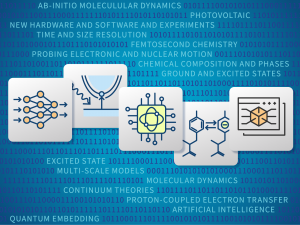April 4, 2024 — A diverse group of computational chemists is encouraging the research community to embrace a sustainable software ecosystem. That’s the message behind a recent perspective article published in the Journal of Chemical Theory and Computation. The authors discuss possible scenarios of how to develop software in the face of a changing computational landscape.

“With more computing power, we can examine additional facets of chemistry,” said Karol Kowalski, a computational chemist at Pacific Northwest National Laboratory (PNNL) and corresponding author of the paper. “I think that computational chemistry will play a huge role in developing our understanding of important chemical processes in the 21st century. We can use simulations to help guide and scope experimental studies in a powerful loop.”
Computing paradigms are in transition, with large-scale and quantum systems emerging as central to computing’s future. These new technologies will allow researchers to solve different and more complicated chemistry problems. But with new opportunities come new challenges, including creating integrated software that can seamlessly work together.
There is an ever-increasing number of specialized chemistry software packages targeted toward solving specific types of problems. As the questions asked by computational chemistry continue to increase in complexity, researchers need to utilize different programs to address them. Combined with the changes to computing technologies, the field is at an important point for looking into the future.
“We need to ensure our approaches can fully use new developments in exascale machines, cloud computing, and quantum computing,” said Kowalski. “This requires planning for the future and anticipating the new challenges that will arise.”
What is Sustainable Software?
In the article, the authors defined sustainable software as a system of different software packages that can be assembled and used as a cohesive system to tackle a broad range of chemistry problems.
“As the questions we’re asking are getting more complicated, so is the process for finding suitable techniques to tackle them,” said Niri Govind, a PNNL computational chemist and co-author of the paper. “We need to work together across different platforms to generate the most meaningful results. Doing this effectively requires establishing standards for the field.”
The computational chemistry ecosystem represents a valuable testing ground for new methods. The problems faced by computational chemists and their software aren’t unique to chemistry—they can be found across scientific modeling efforts. As one of the most established computational environments in science, development teams have consistently been in contact and collaborated throughout recent years.
Collaborative efforts and knowledge-sharing is essential because often a single problem requires the use of multiple types of software to accurately capture the complexity of real-world systems. Often research teams have a narrow focus while developing software which yields new capabilities to tackle specific problems. This ever-increasing ecosystem complexity leads to increasing collaboration as expertise narrows.
Shaping Chemistry with Computation
Not too long ago, computational chemistry simulations served primarily as validators of experimental findings. However, as computing power has increased, so has the ability of computational chemistry not just to validate, but to solve complex problems, to guide and interpret experiments, and to enable predictions.
As the range of knowledge that can be gained from computational chemistry has expanded, it has come at a cost. The more complicated a simulation, the more computing power and time needed to reach a solution. Planning for the future, the authors argue, requires navigating the increasing demands of new problems, adapting to the requirements of next-generation computing architectures, and developing full interoperability.
Members of the Computational and Theoretical Chemistry Institute (CTCI) at PNNL are tackling this challenge through innovative, scalable solutions on current and future computational platforms
“Through the CTCI, we have established an institutional framework to develop the next generation of computational chemistry software for leadership-class computing facilities,” said Sotiris Xantheas, CTCI Director and co-author of the paper. “Using a combination of computer science efforts with novel science tools, artificial intelligence, and quantum computing, the CTCI is poised to develop the next-generation molecular modeling capabilities.”
Workshopping for Sustainable Software
The perspective article emerged from discussions at the 2022 workshop “Sustainable Computational Chemistry Software Development and Integration,” which was supported by the Department of Energy, Office of Science, Chemical Sciences, Geosciences, and Biosciences Division, Computational and Theoretical Chemistry Program.
There, attendees discussed software infrastructure needs and investments to realize the full potential of emerging computing resources. The meeting brought together researchers from across the computational chemistry community.
During the workshop discussions, developers realized they were consistently facing similar problems adapting to new computing resources and developing integrable software. Individual teams realized they could draw on experiences from others who have already found solutions to emerging problems.
PNNL researchers have continued those conversations, working closely with academic, National Laboratory, and industry partners to create innovative new tools for scientific discovery through projects such as TEC4 (Transferring Exascale Computational Chemistry to Cloud Computing Environment and Emerging Hardware Technologies).
The authors concurred that sustainable software development allows the field to move faster across the board without requiring researchers to consistently reinvent existing fixes. This strategy makes investments more efficient, as collaboration also builds bridges of internal consistency across different programs. The authors recognize the need for continued adaptation of software to meet both scientific and hardware needs.
“This work comes from our current perspective,” said Govind. “This isn’t a static plan. We all need to be prepared to embrace new and evolving points of view.”
About PNNL
Pacific Northwest National Laboratory draws on its distinguishing strengths in chemistry, Earth sciences, biology and data science to advance scientific knowledge and address challenges in sustainable energy and national security. Founded in 1965, PNNL is operated by Battelle for the Department of Energy’s Office of Science, which is the single largest supporter of basic research in the physical sciences in the United States. DOE’s Office of Science is working to address some of the most pressing challenges of our time.
Source: Beth Mundy, PNNL



























































